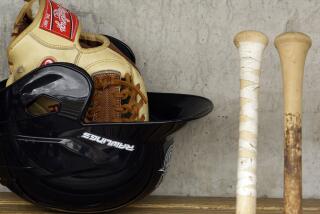HACIENDA HEIGHTS : A Buddhist Outpost for Southland
Twisting through sharp switchbacks and hugging the side of a steep incline, the road has a mountain quality, even though it ascends just a few hundred feet. At the crest, a traveler can view part of a large valley, bracketed by twin ridges extending north like half-opened arms.
An ornate Buddhist monastery occupies about 15 acres near the hilltop. A towering gate invites visitors to ascend broad marble steps and enter the complex. Near the entrance, monks and nuns can be seen in gray or black robes. Heads shaven, they move purposefully along walkways paved in marble.
The air is permeated with the sweet smell of incense. Bowls of fruit are offered before statues guarding the entrances to huge buildings.
Despite its size, the Fo Kuang Shan Hsi Lai Temple is merely an outpost in almost virgin territory. The mother temple, in Taiwan, is 10 times larger.
This outpost is not in a remote territory of China or India. It lies about two miles north of Orange County, on the northern slopes of the Puente Hills in Hacienda Heights.
Built in 1988, the temple has four stated purposes: to train religious teachers, to offer classes and seminars on Buddhism, to provide social and health programs and to enhance spiritual growth.
The buildings total more than 100,000 square feet and have room for several thousand visitors. The architecture is described as “traditional Chinese palace style” and features curving tiled roofs, bright red columns, broad marble staircases and magnificent halls.
Statues occupy recessed chambers high on the walls of each of two major chambers. The first is the Bodhisattva Hall. According to Buddhist beliefs, a bodhisattva is a person who is committed to liberating all beings from suffering.
Visitor information is available near the entrance to this first great hall. Guests are allowed access to most areas of the complex and may eat a vegetarian lunch, served from 11:30 a.m. to 1:30 p.m., seven days each week. The temple is open daily from 9 a.m. to 4 p.m. There is no charge for admission or lunch, but donations are requested.
The second, even more impressive hall is the Buddha Hall, at the opposite end of a large courtyard. Religious ceremonies take place in this hall, which is filled with thousands of small Buddhas, each identified with the name of a person who has made an offering. Opposite the entrance are three giant Buddhas, depicting three different manifestations of enlightenment.
The temple includes a meeting hall with space for an audience of more than 250, a conference room, library, art gallery, a gift shop and several meeting rooms. Visitors are invited to view videos that explain various aspects of Buddhism.
The art gallery includes sculpture and tapestries, most of which portray one Buddha or another. Some of the pieces are hundreds of years old; the exhibit includes works in marble, wood and jade.
Temple officials estimate that 70,000 Buddhist followers live in Orange and Los Angeles counties. These individuals view the new temple as a regional headquarters.
Its address is 3456 Glenmark Drive, off Hacienda Boulevard, a winding artery that links Orange and Los Angeles counties.
The temple was built for more than $25 million. It joins existing centers in San Diego and in Northern California. Buddhist officials estimate that 5 million to 8 million Buddhists live in the United States.
More to Read
Sign up for The Wild
We’ll help you find the best places to hike, bike and run, as well as the perfect silent spots for meditation and yoga.
You may occasionally receive promotional content from the Los Angeles Times.





